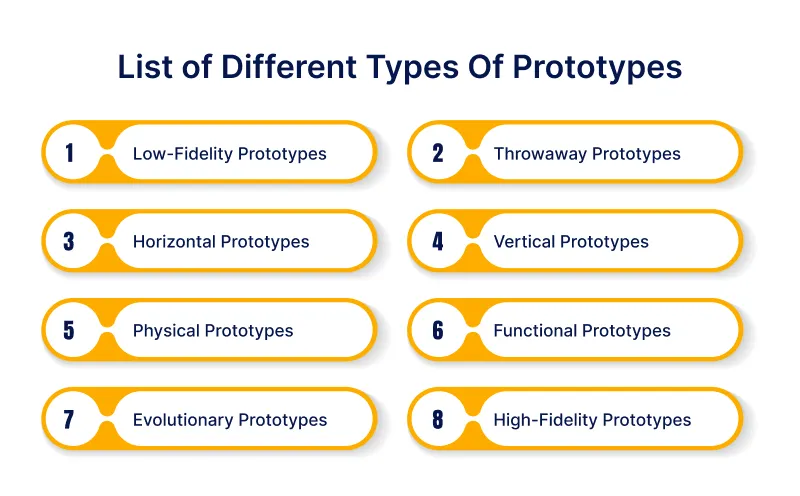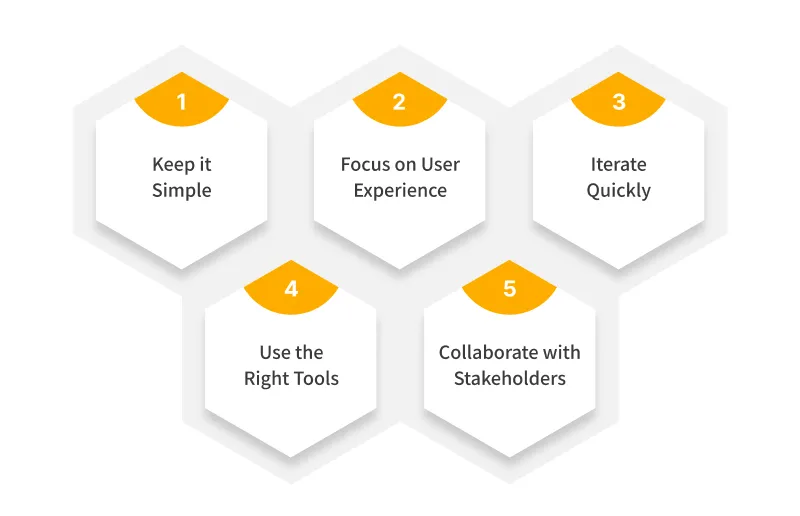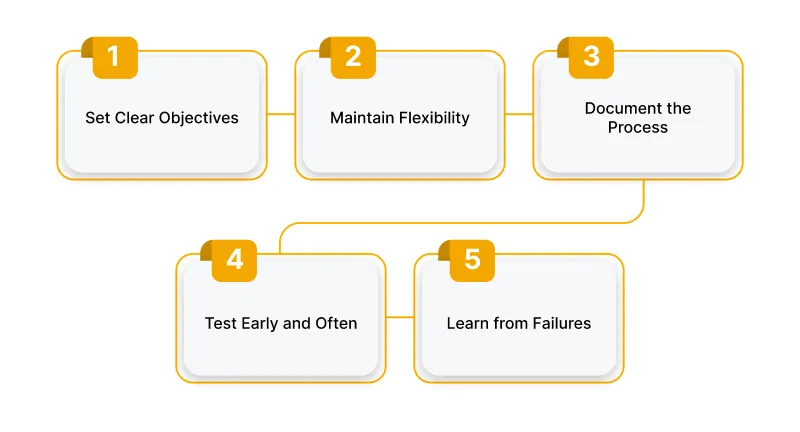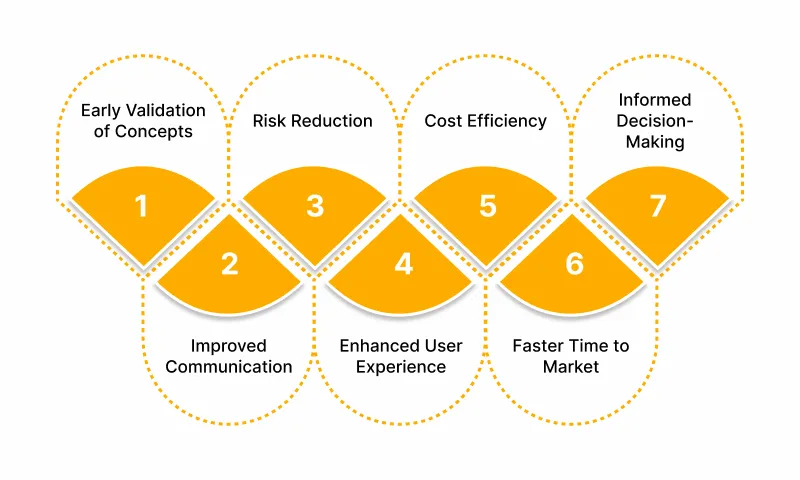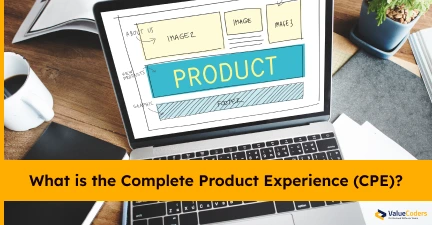Have you ever wondered why some products fail to attract potential consumers while others soar to success?
The difference primarily lies in an overlooked step – the Product Prototyping.
Product prototyping is an essential phase in outsourced software product development. It allows software teams to convert their ideas into tangible models, test functionality, and refine concepts before full-scale production.
In this blog post, you will learn the essential steps, share expert tips of product prototyping, and explore best practices to help you create prototypes that meet and exceed expectations, setting the stage for a successful product launch.
Understanding Product Prototyping
Product prototyping is an indispensable step in outsourced software product development. It is a tangible representation of your idea that allows you to explore how the product might look, feel, and perform before moving on to full-scale production.
Developers and stakeholders can identify potential flaws, make improvements, and ensure the final product meets the intended goals by creating a prototype. Different types of prototypes are listed as:
1. Low-Fidelity Prototypes: These are simple, often rough sketches or paper models focusing on basic functionality and layout rather than detailed design. They are helpful for initial brainstorming and concept validation.
2. Throwaway Prototypes: They are temporary models built to explore ideas and concepts. They’re discarded once they’ve served their purpose, and the lessons are applied to the next iteration.
3. Horizontal Prototypes: Horizontal Prototypes focus on a broad view of the system, covering many features but superficially. They are useful for understanding the overall user experience and flow.
4. Vertical Prototypes: They delve deep into specific features or components of the product, allowing for thorough testing of particular functions.
5. Physical Prototypes: These tangible models represent a product’s physical aspects. They are especially common in manufacturing industries where the product’s physical form, weight, and materials are crucial.
6. Functional Prototypes: These prototypes mimic the actual functioning of the product. They test whether the product performs as expected and can range from simple mock-ups to complex, fully operational models.
7. Evolutionary Prototypes: Unlike throwaway prototypes, evolutionary prototypes are continuously refined and eventually evolve into the final product. This approach is often used in prototype development, where ongoing iterations lead to the finished product.
8. High-Fidelity Prototypes: These are more polished and closer to the final product regarding design, functionality, and user interaction. High-fidelity prototypes are typically used for detailed prototype testing and user feedback.
Let ValueCoders’ expert teams bring clarity and efficiency to your product development process.
When Do You Need To Work on Product Prototyping?
Product prototyping is essential in the software development life cycle, but its actual value emerges during the product discovery phase. This is when ideas are still taking shape, and there’s a need to explore different approaches, test assumptions, and visualize concepts.
By prototyping early, teams can identify potential challenges, gather user feedback, and refine their ideas before committing to the final product. This approach saves time and resources and ensures that the final product aligns closely with user needs and market demands.
The primary goal of product prototyping is to bridge the gap between concept and reality. By creating prototypes, you can:
- Identify any potential issues or areas for improvement early on.
- Collect valuable feedback. This input is essential for refining the product to better meet user needs and expectations.
- Make adjustments, refine the design, and gradually improve the product until it’s ready for production.
Steps to Prototype a Software Product
Have a look at the step-by-step process of prototyping a product, emphasizing the importance of each stage and how it contributes to the successful development of a viable product.
Step 1: Define Your Goals
The first step in prototyping is to define your goals clearly. What do you hope to achieve with your prototype? Are you testing the feasibility of a concept, validating a design, or gathering user feedback?
Identifying the key features and functionalities you want to test will help guide the entire prototyping process, ensuring that your efforts are focused and aligned with your objectives.
Step 2: Research and Gather Requirements
Understanding your target audience’s needs, preferences, and pain points will inform your design decisions and help you create a prototype that addresses real-world problems.
This step involves studying competitors, analyzing market trends, and engaging with potential users to collect valuable insights.
With ValueCoders’ efficient prototyping services, refine your product before scaling production.
Step 3: Sketch Your Ideas
Sketching is a low-cost, low-commitment way to experiment with ideas and lay the groundwork for more detailed designs.
You can start sketching your ideas after clearly understanding your goals and user requirements. This step involves creating basic sketches that visualize your product’s concept.
Whether you prefer using pen and paper or digital sketching tools, the goal is to quickly capture the essence of your product and explore different design possibilities.
Step 4: Create Wireframes
Wireframes are simplified schematic representations of your product’s structure and layout. They focus on the arrangement of elements, navigation, and overall user flow, without getting into the details of visual design.
Tools like Balsamiq or Sketch are commonly used to create wireframes, helping you map out the user experience and identify potential usability issues early on.
Step 5: Develop a Low-Fidelity Prototype
With your wireframes in place, it’s time to build a low-fidelity prototype. This basic version of your product allows you to test core concepts and functionalities without investing too much time or resources.
Low-fidelity prototypes, often created using tools like Adobe XD or Figma, are ideal for initial testing and experimentation. The focus here is on validating the overall concept rather than the finer details.
Step 6: Gather Feedback
Conduct usability tests, observe how users interact with the prototype, and collect their opinions on what works and doesn’t.
Analyzing this feedback will provide valuable insights into how well your product meets user needs and where improvements are necessary.
Step 7: Iterate and Improve
Based on the feedback you’ve gathered, make the necessary changes to your prototype. This iterative process involves refining your design, enhancing functionality, and addressing any issues identified during prototype testing.
The goal is to improve your prototype incrementally, getting closer to the final product with each prototype iteration.
Step 8: Create a High-Fidelity Prototype
After several iterations, you’ll be ready to develop a high-fidelity prototype. Your product’s detailed, interactive version closely resembles the final product in design, functionality, and user experience.
At this stage, advanced prototyping tools and rapid prototyping techniques are used to create a polished, fully functional prototype that can be used for final testing and presentations to stakeholders.
Step 9: Final Testing and Validation
The last step in the prototyping process is final testing and validation. Conduct testing with potential users to ensure the prototype meets all requirements and expectations.
This step involves validating the product’s design, functionality, and user experience, ensuring everything works as intended before moving on to production.
Also Read: The Role of Digital Transformation in Product Engineering
Common Prototyping Mistakes to Avoid
Avoiding these common mistakes will help the best custom software development company maximize its prototyping efforts, leading to a more successful and user-centered final product.
1. Skipping User Testing: One of the biggest mistakes is bypassing user testing. Prototypes are meant to be tested with real users to gather insights and feedback. This crucial step allows you to develop a product that meets user needs and expectations.
2. Overcomplicating the Prototype: Prototypes should be simple and focused on key functionalities, but overcomplicating them can lead to wasted resources and time. Stick to the core features you want to test and refine, keeping the prototype manageable and clear.
3. Failing to Iterate: Refraining from refining and improving your prototype as per feedback is a missed opportunity. Prototype iteration allows you to continuously enhance the software product development process, ensuring the final product is as polished.
4. Ignoring Feedback: Collecting feedback is only valuable if you act on it. Ignoring user or stakeholder feedback can lead to missed improvements and potential flaws in the final product. Be open to constructive criticism and use it to inform your iterations.
5. Confusing Prototypes with Final Products: A prototype is not the final product. It’s a tool to test ideas and concepts. Confusing the two can lead to premature scaling or unrealistic expectations. Remember that a prototype is a work in progress, not a finished product.
6. Using the Wrong Tool: Choosing the wrong prototyping tool can hinder the process. Different tools serve different purposes, so select one that matches your project’s needs. Using the right tool ensures efficiency and effectiveness in creating and testing your prototype.
Transform your ideas into fully functional prototypes quickly and efficiently with ValueCoders’ expertise.
Tips for Effective Product Prototyping
The following practical tips make the product prototyping process more effective and emphasize simplicity, user focus, quick iterations, the right tools, and collaboration.
Keep it Simple
Begin with basic designs that capture your product’s core functionality and concept. This approach lets you focus on the essentials. Keeping it simple initially helps make the prototyping process more manageable and cost-effective.
Focus on User Experience
Engage users early and often, gathering feedback on usability, design, and functionality. By focusing on UX, you can ensure that the user-driven software products provide a seamless, enjoyable experience, leading to higher user satisfaction and adoption rates.
Iterate Quickly
Don’t hesitate to make rapid changes based on the feedback you receive. Each iteration aims to learn, adapt, and improve the prototype. Quick iterations allow you to test ideas, experiment with new features, and address issues.
Use the Right Tools
Select product prototyping tools that align with your needs, technical skills, and project complexity. Whether using simple sketching tools, wireframing software, or advanced interactive prototyping platforms, ensure they empower you to create, test, and iterate.
Collaborate with Stakeholders
Collaboration ensures that different perspectives are considered and the prototype aligns with the overall business goals and user expectations. Regular communication with stakeholders helps identify potential issues early.
Best Practices in Product Prototyping
Using the following prototyping best practices, you can maximize the effectiveness of your product prototyping efforts and increase the likelihood of creating a product that meets user needs and stands out in the market.
Set Clear Objectives
Define your objectives for your prototype. Clear objectives will guide your design decisions and ensure that the prototype is focused on testing specific aspects of the product.
Maintain Flexibility
Be open to new ideas, changes, and unexpected insights that emerge during testing. Flexibility allows you to adapt your approach as you learn more about user needs and technical constraints.
Document the Process
Keep detailed records of each iteration, including design changes, test results, and feedback received. This documentation is invaluable for tracking progress, understanding why certain decisions were made, and ensuring continuity if team members change.
Test Early and Often
Testing early allows you to catch potential design, functionality, or user experience flaws, saving time and resources in the long run. Frequent testing also keeps the project aligned with user needs.
Learn from Failures
Not every prototype will succeed, and that’s okay. Use unsuccessful attempts as learning opportunities to refine your approach and improve the next iteration. Embracing failure as part of the process fosters innovation and produces a more robust final product.
Also Read: From Idea to Market: Unveiling 7 Crucial Stages of New Product Development
Advantages of Product Prototyping
Prototyping is a powerful tool that enhances product development and increases the chances of creating a successful, user-centered product. Hire developers to leverage the benefits of product prototyping for your new product.
Early Validation of Concepts
Prototyping allows you to validate your ideas and concepts early in development. By creating a tangible version of your product, you can test its functionality, design, and user experience, ensuring that it aligns with market needs before moving to full-scale production.
Improved Communication
Prototypes serve as a visual and functional representation of your ideas, making it easier to communicate your vision to stakeholders, team members, and potential investors. This clarity helps gather feedback and ensure everyone is on the same page.
Risk Reduction
By identifying potential issues early through prototyping, you can avoid costly mistakes later in development. Prototyping helps you catch design flaws, usability problems, or technical challenges before they escalate, reducing the risk of product failure.
Enhanced User Experience
Prototyping allows for user testing and feedback, enabling you to refine the product based on real user interactions. This iterative process helps create a product that better meets user needs and provides a more satisfying experience.
Cost Efficiency
Although prototyping requires an initial investment of time and resources, it can save costs.
By identifying and addressing issues early, you avoid expensive revisions during the crucial stages of new product development, leading to a more efficient and cost-effective process.
Faster Time to Market
Prototyping accelerates the development process by allowing for quicker iterations and refinements. By testing and improving the product early, you streamline the path from concept to launch, enabling you to bring your product to market faster.
Informed Decision-Making
Prototyping provides concrete data and insights that inform decision-making throughout the development process. By testing different aspects of the product, you gain valuable information that helps guide design choices, feature prioritization, and overall product strategy.
Use ValueCoders' prototyping expertise to test your product concepts before full-scale production.
Case Studies of Successful Prototyping
Have a look at the following companies who have successful product prototyping:
Airbnb
When the founders first conceived the idea of Airbnb, they created a simple, low-fidelity prototype to validate their concept of renting out air mattresses in their apartments. The prototype was a basic website that allowed users to list their space and book accommodations.
By starting small and testing the concept with real users, Airbnb was able to gather invaluable feedback, iterate on their design, and gradually build a platform that today is valued at billions of dollars. Their commitment to prototyping and user testing was instrumental in refining their service and ensuring that it met the needs of both hosts and guests.
One notable example is the development of Google Glass. Before the product was ever announced, Google’s engineers and designers created numerous prototypes, ranging from simple cardboard mockups to functional electronic models.
These prototypes were tested extensively with users to understand the product’s potential and identify any usability issues. Although Google Glass didn’t achieve commercial success, the prototyping process allowed Google to explore new technologies and insights.
Dropbox
Instead of building a complex product immediately, Houston created a simple video prototype demonstrating how Dropbox would work. The video featured a basic walkthrough of the product’s functionality and was shared with users to gauge interest and collect feedback.
This approach allowed Dropbox to validate the demand for its product without investing heavily in development upfront. The overwhelmingly positive response to the video prototype convinced investors and users alike, leading to Dropbox’s successful launch.
Apple
Before the first iPhone was released, Apple created numerous prototypes, experimenting with different designs, interfaces, and functionalities.
These prototypes ranged from low-fidelity sketches and foam models to fully functional devices rigorously tested for usability, performance, and user experience.
The iterative process allowed Apple to refine every aspect of the iPhone, leading to a product launch that revolutionized the smartphone industry.
Nike
When Nike set out to develop the Flyknit technology, which involves creating shoes with a one-piece knit upper, the design team relied heavily on rapid prototyping to refine the concept.
Using 3D printing and advanced knitting machines, Nike quickly created multiple prototypes, allowing them to test different materials, patterns, and structures.
The success of the Flyknit technology revolutionized Nike’s approach to shoe design and set a new standard in the footwear industry for sustainability and innovation.
Conclusion
Prototyping is more than just a step in software product development as it bridges concepts and reality.
By following the above-discussed steps/best practices and utilizing startup product development services for product prototyping, you can minimize risks and maximize your product’s potential for success.
Whether you’re refining your design or testing functionality, each iteration brings you closer to a product that resonates with users and stands out in the market.
Partner with ValueCoders, one of India’s best custom software development companies, as our dedicated development teams do product prototyping for your next project. We have 19+ years of business excellence in offshore software development. Contact us today!

